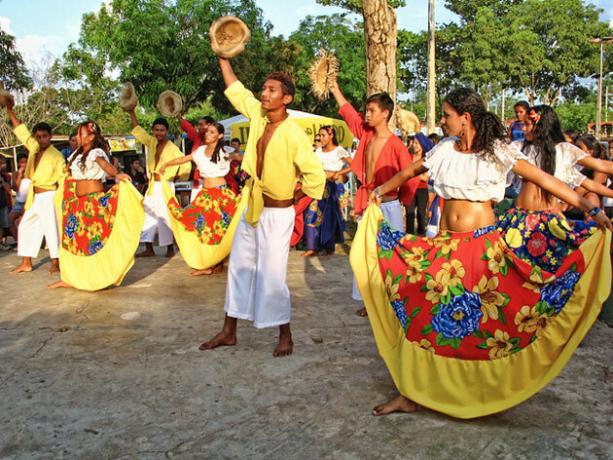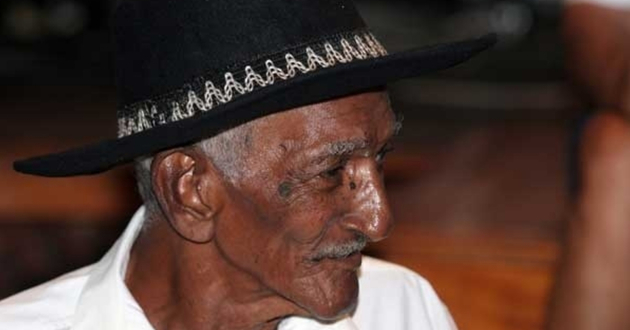Carimbó is a typical circle dance from the northeast of Pará, a state in the North of Brazil, popular among northerners and northeasterners.
Also called Pau e Corda, Samba de roda of Marajó and Baião typical of Marajó, the carimbó dance is performed in pairs and marked by rotating movements.
Origin of stamp
The word "carimbó" is of indigenous origin. from tupi korimbo (stick that produces sound) results from the joining of the elements curi, which means "stick", and mbo, which means “pierced”.
The name refers to the curimbo, the main musical instrument used in this folkloric manifestation. The curimbó is a kind of drum played with the hands, made from a hollow hollow trunk.
The carimbó from Pará was brought to Brazil by African slaves. Later, indigenous and European influences were incorporated, especially Iberian.
The custom of dancing emerged from the habit of farmers and fishermen who, at the end of their daily work, danced to the rhythm of the drum.

Types of stamp
The types of carimbó arise as a result of the professional occupation developed by the participants, which may vary according to location in the state.
These activities give rise to the lyrics of the songs sung in carimbó, as they contain everyday stories.
Taking into account the size of Pará, at least the following types emerge:
- praieiro stamp
- pastoral stamp
- rural stamp
Stamp instruments
To play the carimbó music, two curimbós are used, essential drums in the execution of the carimbó of Pará.

Besides the curimbó, some more instruments are used: afoxé, banjo, flute, ganzá, maraca, tambourine and reco-reco.
stamp clothes
The clothes used are of the characteristics of the carimbó that stand out the most.
Women's skirts are very colorful, quite voluminous and full, to ensure a more beautiful effect to the dance movement.
The blouses are usually in one color and, on the feet, they don't wear any shoes. In addition, women wear neck and wrist ornaments, and decorate their hair with flowers.
Men's clothing, on the other hand, is simple and resembles the dress of certain workers who wear short or folded pants. Like women, men also dance barefoot.

Carimbó Choreography
The carimbó dance is done in pairs, which form a circle. The boy invites the girl to the dance by clapping his hands in front of her.
With skirts, women perform movements trying to cover the heads of their peers.
There are steps that mimic animal movements. This is the case of the turkey dance step or turkey carimbó step, which is performed when a couple goes to the center of the circle.
At this moment of the choreography, the dancer leaves a handkerchief on the floor, which must be picked up by the dancer using only her mouth, to the sound of:
"The Atalaia turkey,
shoo, turkey,
The turkey and the turkey,
shoo, turkey,
The turkey is on the wheel,
shoo, turkey,
Turkey is a beast,
sho, turkey,
The turkey and the turkey,
shoo, turkey,
pick up the turkey scarf
shoo, turkey.
The turkey took the xô scarf, turkey."
If the dancer succeeds, he is applauded and remains in the dance. Otherwise, he abandons the dance to jeers.

Carimbó do Macaco, by Pinduca
O Monkey's Stamp is a very popular song by the artist from Pará Pinduca, who is considered the King of Modern Carimbó.
Check out the lyrics of Carimbó do Macaco:
“I want to see, oh girl I want to see
I want to see, you now balk
I want to see, oh girl I want to see
the monkey's stamp
that I made you to sing
It's monkey scatter monkey
monkey, au monkey
the monkey o monkey
the monkey of the monkey
I know a little monkey
Who is the son of the overalls
grandson of the old monkey
Who lives in the backlands.”
Curiosities about carimbó
In 2014, after ten years of inventory, the carimbó was declared (unanimously) by the Advisory Council for Cultural Heritage as Intangible Cultural Heritage of Brazil,
On November 11, 2015, this folk dance from Pará officially received the title of Cultural Heritage of Brazil, by IPHAN (Institute of National Historical and Artistic Heritage).
Another interesting fact about carimbó is that, in Pará, the 26th of August is the Municipal Day of Carimbó. This is the birth day of Mestre Verequete, a musician who became known as Rei do Carimbó.

Were you curious to know more about other dances? Be sure to consult the texts below:
- African dances as a form of cultural communication
- Maracatu: characteristics and differences between nation and rural maracatu
- Bumba meu boi: origin, legend, dance and parties
- Catira or Cateretê: origin, dances and music
- Frevo: origin, characteristics and types of dance
- Quadrilha: origin, dance, music and characteristics
- Samba de Roda: origin, characteristics, dance and music
- History of Samba



